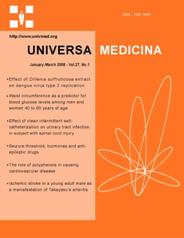Effect of clean intermittent self-catheterization on urinary tract infection in subject with spinal cord injury
Main Article Content
Abstract
Article Details
Issue
Section
The journal allows the authors to hold the copyright without restrictions and allow the authors to retain publishing rights without restrictions.
How to Cite
References
DeVivo MJ, Krause JS, Lammertse DP. Recent trends in mortality and cause of death among persons with spinal cord injury. Arch Phys Med Rehabil 1999; 80: 1411-9.
Siroky MB. Pathogenesis of bacteruria and infection in the spinal cord injured patient. Am J Med 2002; 113 (Suppl 1A): S67-S79.
Garcia Leoni ME, Esclarin De Ruz A. Management of urinary tract infection in patients with spinal cord injuries. Clin Microbiol Infect 2003; 9: 780-5.
Lindsey L, Klebine P. Bladder care and management. 2001. Available at: http://images. main.uab.edu/spinalcord/pdffiles/info-11.pdf. Accessed December 12, 2006.
Svensson E, Ertzgaard P, Forsum U. Bacteriuria in spinal cord injured patients with neurogenic bladder dysfunction. Upsala J Med Sci 2004; 109: 25-32.
Barton R. Intermittent self-catheterization. Nurs Stand 2000; 15: 47-52.
Duffin H. Intermittent self-catheterization. J Comm Nurs 2000; 14: 29-32.
Kovindha A, Mai W NC, Madersbacher H. Reused silicone catheter for clean intermittent catheterization (CIC): is it safe for spinal cord-injured (SCI) men? Spinal Cord 2004; 42: 638-42.
Wyndaele JJ, De Ridder D, Everaert K, Heilporn A, Congard-Chassol B. Evaluation of the use of Urocath Gel catheters for intermittent self-catheterization by male patients using conventional catheters for a long time. Spinal Cord 2000; 38: 97-9.
Parmar S, Baltej S, Vaidyanathan S. Teaching the procedure of clean intermittent catheterization. Paraplegia 1993; 31: 298-302.
Prieto-Fingerhut T, Banovac K, Lynne CM. A study comparing sterile and nonsterile urethral catheterization in patients with spinal cord injury. Rehabil Nurs 1997; 22: 299-302.
Biering-Sorensen F, Bagi P, Hoiby N. Urinary tract infections in patients with spinal cord injuries. Drugs Aging 2001; 61: 1275-87.
Young W, W.M. Keck Center for Collaborative Neuroscience Rutgers University, Piscataway, NJ. Spinal Cord Injury Levels & Classification. 2002. Available at: http://www.sci-info-pages.com/levels.html. Accessed December 18, 2006.
Winn C, Thompson J. Urinary catheters for intermittent use. Prof Nurse 1999; 14: 859-65.
Moore KN, Burt J. Intermittent catheterization in the rehabilitation setting: a comparison of clean and sterile technique. Clin Rehab 2006; 20: 461-8.
Lemke JR, Kasprowicz K, Worral PS. Intermittent catheterization for patients with a neurogenic bladder: sterile versus clean. J Nurs Care Quat 2005; 20: 302-6.
Biering-Sorensen F, Bagi P, Hoiby N. Urinary tract infections in patients with spinal cord injuries. Drugs Aging 2001; 61: 1275-87.
De Ridder DJMK, Everaert K, Garcia Fernandez L. Intermittent catheterization with hydrophiliccoated catheters (SpeediCath) reduces the risk of clinical urinary tract infection in spinal cord injured patients: a prospective randomized parallel comparative trial. Eur Urol 2005; 48: 991-5.
Svensson E, Ertzgaard P, Forsum U. Bacteriuria in spinal cord injured patients with neurogenic bladder dysfunction. Upsala J Med Sci 2004; 109: 25-32.
Giannantoni A, Scivoletto G, Di Stasi SM, Silecchia1 A, Finazzi-AgroÁ E, Micali I, et al. Clean intermittent catheterization and prevention of renal disease in spinal cord injury patients. Spinal Cord 1998; 36: 29-32.
Wyndaele JJ, De Ridder D, Everaert K, Heilporn A, Congard-Chassol B. Evaluation of the use of Urocath-Gel1 catheters for intermittent self-catheterization by male patients using conventional catheters. Spinal Cord 2000; 38: 97-9.


